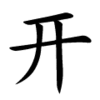开
Jump to navigation
Jump to search
| ||||||||
Translingual
[edit]| Stroke order | |||
|---|---|---|---|

| |||
| Stroke order | |||
|---|---|---|---|
Han character
[edit]开 (Kangxi radical 55, 廾+1, 4 strokes, cangjie input 一廿 (MT), four-corner 10440, composition ⿱一廾)
Derived characters
[edit]See also
[edit]References
[edit]- Kangxi Dictionary: not present, would follow page 353, character 10
- Hanyu Da Zidian (first edition): volume 1, page 514, character 3
- Unihan data for U+5F00
Chinese
[edit]Glyph origin
[edit]Ideogrammic compound (會意/会意) : 干 + 干 (“trunk”). Two trunks are of the same height.
Also Simplified from 開 (elimination of 門).
As a component in composite characters, the part is not directly related to 開 and instead originally derives from 井 (such as in 刑, 型, etc.) or from 幵 (such as in 研, 形, etc.).
Etymology 1
[edit]| For pronunciation and definitions of 开 – see 幵 (“even, level”). (This character is a variant form of 幵). |
Etymology 2
[edit]| For pronunciation and definitions of 开 – see 開 (“to open; to unlatch; to unfasten; to start; to turn on; to switch on; etc.”). (This character is the simplified form of 開). |
Notes:
|
Etymology 3
[edit]| For pronunciation and definitions of 开 – see 亓. (This character is a variant form of 亓). |
Japanese
[edit]Kanji
[edit]开
- Alternative form of 開
Readings
[edit]- Go-on: かい (kai)、け (ke)
- Kan-on: かい (kai)
- Kun: ひらく (hiraku, 开く)、ひらける (hirakeru, 开ける)、あける (akeru, 开ける)、あく (aku, 开く)
- Nanori: さく (saku)、はる (haru)、はるき (haruki)、ひら (hira)、ひらかす (hirakasu)、ひらき (hiraki)、ひらく (hiraku)
Kanji
[edit]| 开 | |
| 幵 |
开
(Hyōgai kanji, shinjitai kanji, kyūjitai form 幵)
Readings
[edit]Vietnamese
[edit]Han character
[edit]References
[edit]Zhuang
[edit]Verb
[edit]开
Categories:
- CJK Unified Ideographs block
- Han script characters
- Translingual lemmas
- Translingual symbols
- CJKV simplified characters which already existed as traditional characters
- Han ideogrammic compounds
- CJKV simplified characters
- Chinese lemmas
- Mandarin lemmas
- Cantonese lemmas
- Hokkien lemmas
- Middle Chinese lemmas
- Old Chinese lemmas
- Chinese hanzi
- Mandarin hanzi
- Cantonese hanzi
- Hokkien hanzi
- Middle Chinese hanzi
- Old Chinese hanzi
- Chinese adjectives
- Mandarin adjectives
- Cantonese adjectives
- Hokkien adjectives
- Middle Chinese adjectives
- Old Chinese adjectives
- Chinese proper nouns
- Mandarin proper nouns
- Cantonese proper nouns
- Hokkien proper nouns
- Middle Chinese proper nouns
- Old Chinese proper nouns
- Chinese terms spelled with 开
- Chinese variant forms
- Beginning Mandarin
- Sichuanese lemmas
- Dungan lemmas
- Taishanese lemmas
- Gan lemmas
- Hakka lemmas
- Jin lemmas
- Northern Min lemmas
- Eastern Min lemmas
- Teochew lemmas
- Wu lemmas
- Xiang lemmas
- Sichuanese hanzi
- Dungan hanzi
- Taishanese hanzi
- Gan hanzi
- Hakka hanzi
- Jin hanzi
- Northern Min hanzi
- Eastern Min hanzi
- Teochew hanzi
- Wu hanzi
- Xiang hanzi
- Chinese verbs
- Mandarin verbs
- Sichuanese verbs
- Dungan verbs
- Cantonese verbs
- Taishanese verbs
- Gan verbs
- Hakka verbs
- Jin verbs
- Northern Min verbs
- Eastern Min verbs
- Hokkien verbs
- Teochew verbs
- Wu verbs
- Xiang verbs
- Middle Chinese verbs
- Old Chinese verbs
- Chinese adverbs
- Mandarin adverbs
- Sichuanese adverbs
- Dungan adverbs
- Cantonese adverbs
- Taishanese adverbs
- Gan adverbs
- Hakka adverbs
- Jin adverbs
- Northern Min adverbs
- Eastern Min adverbs
- Hokkien adverbs
- Teochew adverbs
- Wu adverbs
- Xiang adverbs
- Middle Chinese adverbs
- Old Chinese adverbs
- Chinese nouns
- Mandarin nouns
- Sichuanese nouns
- Dungan nouns
- Cantonese nouns
- Taishanese nouns
- Gan nouns
- Hakka nouns
- Jin nouns
- Northern Min nouns
- Eastern Min nouns
- Hokkien nouns
- Teochew nouns
- Wu nouns
- Xiang nouns
- Middle Chinese nouns
- Old Chinese nouns
- Sichuanese proper nouns
- Dungan proper nouns
- Taishanese proper nouns
- Gan proper nouns
- Hakka proper nouns
- Jin proper nouns
- Northern Min proper nouns
- Eastern Min proper nouns
- Teochew proper nouns
- Wu proper nouns
- Xiang proper nouns
- Chinese particles
- Cantonese particles
- Chinese simplified forms
- Japanese kanji
- Japanese hyōgai kanji
- Japanese kanji with goon reading かい
- Japanese kanji with goon reading け
- Japanese kanji with kan'on reading かい
- Japanese kanji with kun reading ひら・く
- Japanese kanji with kun reading ひら・ける
- Japanese kanji with kun reading あ・ける
- Japanese kanji with kun reading あ・く
- Japanese kanji with nanori reading さく
- Japanese kanji with nanori reading はる
- Japanese kanji with nanori reading はるき
- Japanese kanji with nanori reading ひら
- Japanese kanji with nanori reading ひらかす
- Japanese kanji with nanori reading ひらき
- Japanese kanji with nanori reading ひらく
- Japanese kanji with on reading けん
- Japanese kanji with kun reading たいらか
- Vietnamese lemmas
- Vietnamese Han characters
- Zhuang lemmas
- Zhuang verbs
- Zhuang Sawndip forms